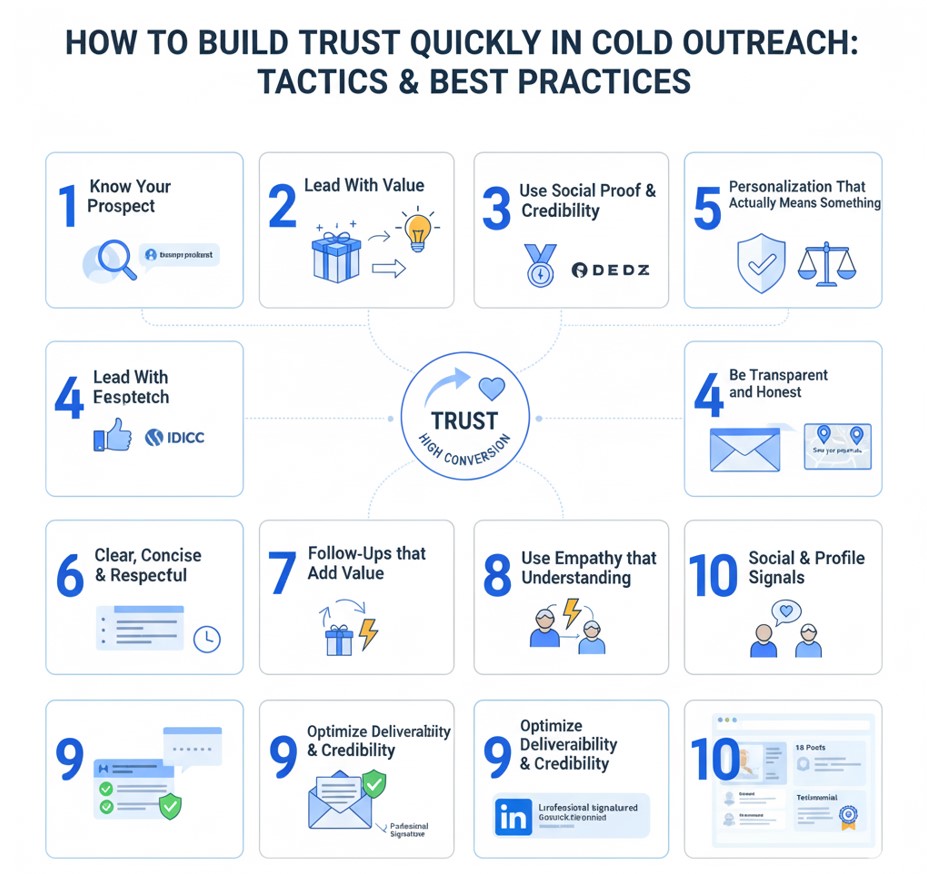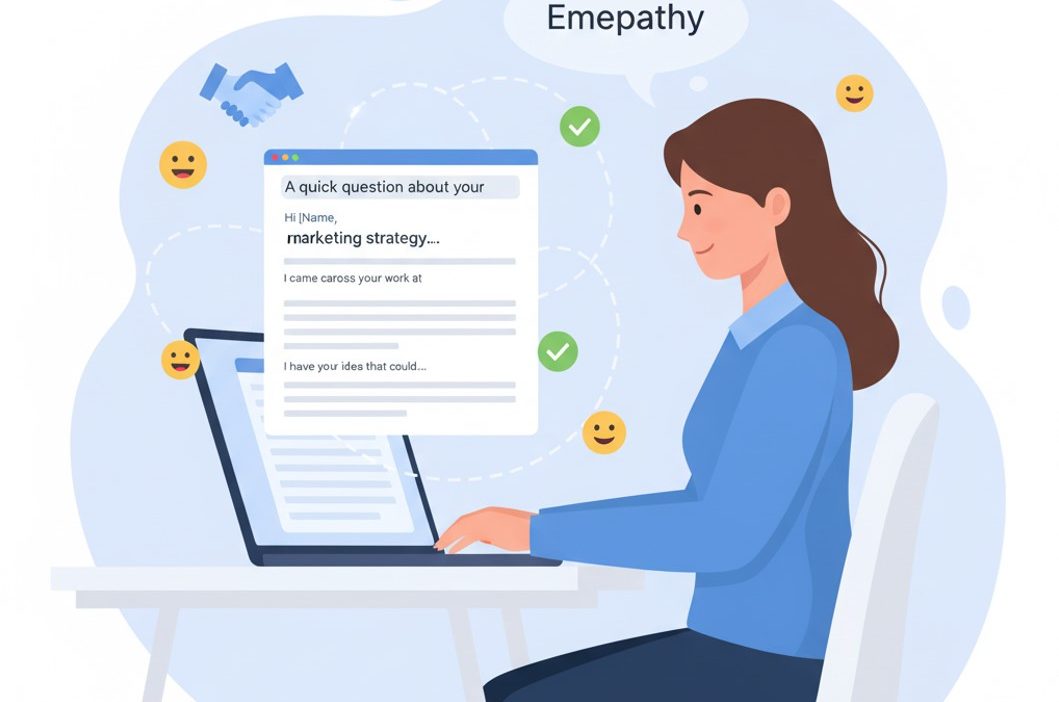Cold outreach is tough. Your prospect doesn’t know you. They’re probably skeptical. The difference between a cold email that’s deleted instantly and one that gets a reply often comes down to trust. If you can build trust quickly in cold outreach, you dramatically improve your open rates, response rates, and ultimately conversions.
In this post, we’ll cover:
- Why trust matters so much in cold outreach
- What behaviors or signals kill trust fast
- How to earn trust fast (tactics & best practices)
- Example framework/templates
- Roadmap + metrics to track
Why Trust Matters So Much in Cold Outreach
Before reaching them, your prospect has already decided a lot based on what they see and feel. These days:
-
Overwhelmed inboxes & ad fatigue
Prospects get a ton of generic emails, marketing messages, sales pitches. If yours comes across like “more of the same,” it’ll be ignored or deleted. Trust helps you stand out. -
Longer decision cycles
Especially in B2B, decisions often involve multiple people, budgets, risks. Trust reduces perceived risk. If they trust you, they’ll more willingly move forward. -
Credibility is a differentiator
Many companies offer similar services. Good trust can differentiate you—even if you don’t have the flashiest product. Proof, transparency, and empathy matter. -
Word-of-mouth & referrals rest on trust
Early prospects often check reviews, case studies, or ask peers. Building trust early means fewer objections later, fewer friction points.
What Destroys Trust Fast in Cold Outreach
Knowing what not to do helps sharpen your strategy. Here are common trust‑killers:
- Generic, mass messages
If your email could have been sent to 1000 others without change, the recipient senses that. It feels impersonal. (“Spray-and-pray” approaches are a fast way to lose credibility.) - Talking only about yourself / your product
If the first thing you do is say how great you are, it feels self‑centered. Prospects don’t care until you show you understand them. Crispme - Overpromising, vague or hyperbolic claims
If you promise something that sounds too good, or use generic hype (“increase revenue 10x”, “revolutionary”, etc.) without proof, trust slips. - Lack of clarity or relevance
If the email doesn’t indicate you know something about their business, or it isn’t clear what value you bring, then it feels like spam. - Bad follow‑ups or broken promises
When you say you’ll send something, call back, or deliver something and then don’t do it—the trust gap widens. Inconsistency is noticed.
How to Build Trust Quickly in Cold Outreach: Tactics & Best Practices

Here are proven strategies (with input from various sources) to build trust fast in your cold outreach programs.
1. Do Your Research First — Know Your Prospect
-
Before reaching out, spend time learning who the person is: their role, recent company news, and challenges their industry is facing. Reference something specific in your message. (“I saw that your company just launched X”, or “I read your post about Y”.)
-
Tailor your message so that it addresses something they care about. This signals respect and that you’re not just sending email blasts.
2. Lead With Value—Give Before You Ask
- Offer something useful right away without asking for a big commitment. Maybe a tip, an insight, a free resource relevant to their business challenge.
- This could be a relevant blog post, a case study showing how you solved a problem for a similar company, or even a suggestion/question that shows you’ve thought about their situation.
3. Use Social Proof & Credibility Signals
- When possible, include short examples, case studies, or testimonials from clients similar to them. If you’ve worked in their industry or with companies like theirs, mention that. That helps prospects see that you are legitimate.
- Certifications, awards, or memberships in trusted communities also help. On LinkedIn, client logos, endorsements, and project highlights contribute significantly. coldoutreachagency.com
4. Be Transparent and Honest
- Don’t hide the costs, limitations, or challenges. If there are conditions or things you don’t do well, better to communicate clearly up front rather than lead to disappointment. Transparency builds long‑term trust.
- If you make promises — follow‑ups, sending resources, replying — ensure you deliver. Consistency and reliability matter.
5. Use Personalization That Actually Means Something
-
Using a name is obvious; referencing real work, roles, or achievements of the prospect is stronger. “I saw you’ve expanded into X market”, or “I saw your recent LinkedIn post on Y” shows you did actual homework. Crispme+1
-
Segment your outreach list so your messages are relevant. Someone in healthcare will react differently from someone in SaaS.
6. Keep Messaging Clear, Concise, and Respectful
- The email should be easy to scan: short paragraphs, clear subject line, specific request. Don’t bury your ask or benefit deep in a wall of text.
- Respect your prospect’s time and inbox: try not to be demanding; give options instead of insisting. “If this is of interest, happy to send more info / schedule a quick 10‑min call” is softer than “let’s set up a call now”.
7. Follow‑Ups that Add Value, Not Just Reminders
- Most people won’t reply to the first email. Follow‑ups need to bring something new or helpful (another insight, success story, another resource), not just “did you see my last message?”
- Use behavior‑based triggers: if they opened but didn’t respond, or clicked a link, tailor follow‑up accordingly. It shows attentiveness and relevance.
8. Use Empathy & Understanding
- Try to put yourself in their shoes: what pressures do they face? What objections might they have? Reflect empathy in your language. Something like “I know you’re probably busy with X” or “Many companies in your space struggle with Y” helps.
- Listen (in subsequent messages) or solicit feedback. Show that you’re genuinely interested in solving their problem, not just selling.
9. Optimize Deliverability & Credibility
- Make sure your sending domain is healthy; warm up new domains so they don’t look spammy. Use SPF, DKIM, and DMARC. Ensure your email signature looks professional.
- Avoid overly promotional language, too many links or graphics in first message.
- Make unsubscribe or opt‑out options clear where required. Comply with relevant local laws (CAN‑SPAM, GDPR, etc.).
10. Social & Profile Signals Before You Outreach
-
Prepare your own profiles (LinkedIn, your website, etc.) so they reflect professionalism, credible experience, testimonials and relevant posts. Because many prospects will check you out after receiving your message. They’ll look at your LinkedIn or website. If your profile is weak or inconsistent, it undermines the trust you’re trying to build. coldoutreachagency.com
-
Publish content (short articles, posts) relevant to your prospect’s interests so when they check your profile, they see value.
Example Framework & Sample Messages
Here’s a simple framework you can follow, plus sample messages to illustrate how trust‑building elements can be put together.
Framework
| Stage | What to Do | Key Trust Signal |
|---|---|---|
| Pre‑outreach prep | Research, profile check, and find relevant social proof | Authenticity & relevance |
| First message | Personalized, value offering, transparent | Credibility & empathy |
| Follow‑ups | Add value, reference promise, behave respectfully | Reliability & respect |
| Profile + web presence | Clean LinkedIn, website with case studies | Social proof & consistency |
| Response handling | Listen, clarify, admit limitations, set realistic expectations | Transparency & understanding |
Sample Messages
First Touch Email
Follow‑Up 1
Metrics to Track & Roadmap
To make sure you’re building trust fast and effectively, track these metrics and follow a plan:
Metrics
- Open rates
- Reply rates
- Number of touchpoints before first reply
- Engagement on social proof links or content you send (e.g. case study downloads)
- Percentage of meetings or calls set vs outreach volume
- Unsubscribe or spam complaints
- Bounce rates / deliverability metrics
Roadmap (First 4‑6 Weeks)
| Week | Focus Area |
|---|---|
| Week 1 | Define ideal customer profile, research prospects, optimize your profile/web presence, and gather social proof/case studies. |
| Week 2 | Write and send the first batch of personalized outreach targeting 10‑20 prospects. Give value in the first touch. Be sure deliverability is set up correctly. |
| Week 3 | Follow up two to three times with added value at each follow‑up. Monitor what messaging resonates (open/reply). Adjust subject lines/intros. |
| Week 4 | Review data. Drop or refine messaging for low‑responding segments. Prepare content or resources to support outreach (case studies, insights, mini‑report). |
| Week 5‑6 | Scale outreach. Add behavior‑based or trigger‑based follow‑ups. Keep refining personalization and ensure consistency. |
FAQs
Q: Can trust be built with completely cold outreach?
A: Yes, but it requires more effort in personalization, credibility, value focus, and transparency. The more you can anticipate what the prospect cares about and reflect that in your message, the faster trust forms.
Q: How many follow‑ups are enough?
A: Usually, 3‑4 follow‑ups is reasonable. Each should add something new and useful. If after that there’s no response, it might not be the right time or the right person.
Q: What if I don’t have strong case studies or social proof?
A: Use what you have. Early wins, small clients, and even personal projects can help. Also, thought leadership content (blog posts, useful insights) can help fill in credibility. Be humble, transparent, and focus on the outcome you expect.
Q: How long before I see improvements in response rates if I apply these tactics?
A: You might see better open/reply rates within a week or two as you tweak subject lines, personalize more. Stronger, more meaningful responses may take a couple of weeks as you build consistency and your profile/web presence catches up.
Conclusion
If your goal is to build trust quickly in cold outreach, it’s a mix of strategy + authenticity. The outreach that wins isn’t the loudest or most aggressive—it’s the one that shows you understand the recipient, cares about their problems, deliver value, and communicate honestly.
Remember:
- Do your homework
- Lead with value
- Use credible proof
- Be transparent
- Personalize well
- Follow up with respect
When you do these things well, cold outreach stops being cold—it starts being meaningful. And meaningful outreach gets replies.
Learn more about: How AI Is Changing the Future of Product Marketing





